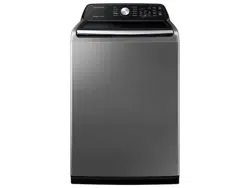Documents: Go to download!
- User Manual - (English, French, Spanish)
- INSTALLATION
- OPERATION
- FUNCTIONS
- MAINTENANCE
- TROUBLESHOOTING
Table of contents
Washer User Manual
INSTALLATION
Basic location requirements
Electrical
- Volt 60 Hz 15 AMP fuse or circuit breaker.
- Individual branch circuit serving only your Washer is recommended.
- Your washer is equipped with a power cord.
CAUTION
Never use an extension cord.
Grounding
Electrical grounding is required for this appliance.
- This appliance must be grounded. In the event of malfunction or breakdown, grounding will reduce the risk of electric shock by providing a path of least resistance for electric current.
- This appliance is equipped with a power cord having a three-prong grounding plug for use in a properly installed and grounded outlet.
- The plug must be plugged into an appropriate outlet that is properly installed and grounded in accordance
WARNING
An improperly connected equipment- grounding conductor can increase the risk of electrical shock. Check with a qualified electrician or serviceman if you are not sure whether the appliance is properly grounded. Do not modify the plug provided with the appliance – if it does not fit the outlet, have a proper outlet installed by a qualified electrician.
Important safety precautions
To prevent unnecessary risk of fire, electrical shock or personal injury, all wiring and grounding must be done in accordance with the National Electrical Code ANSI/FNPA, No.70 Latest Revision and local codes and ordinances. It is the personal responsibility of the appliance owner to provide adequate electrical service for this appliance.
CAUTION
Never connect the ground wire to plastic plumbing lines, gas lines, or hot water pipes.
Water
To correctly fill your Washer in the proper amount of time, water pressure of 20 to psi (137 to 800 kPa) is required. Water pressure less than 20 psi may cause water valve failure, or may not allow the water valve to shut off completely, or may extend the fill time beyond what your Washer controls allow, causing your Washer to turn off. A time limit is built into the controls to prevent flooding in your home if a hose becomes loose.
The water faucets must be within 4 feet (122 cm) to the back of your Washer to match the inlet hoses provided with your Washer.
NOTE
Accessory inlet hoses are available in various lengths up to 10 feet (275 cm) for faucets that are further away from the back of your washer. To avoid the possibility of water damage:
- Have water faucets easily accessible.
- Turn off faucets when the washer is not in use.
- Periodically check that there is no leakage from the water inlet hose fittings.
Drain facility
The recommended height of the standpipe is 39 in (99 cm). The drain hose must be routed through the drain hose clip to the standpipe. The standpipe must be large enough to accept the outside diameter of the drain hose. The drain hose is attached to the washer at the factory.
Flooring
- For best performance, you must install your washer on a solidly constructed floor. Wood floors may need to be reinforced to minimize vibration and/or unbalanced load situations. Carpeting and soft tile surfaces are contributing factors to vibration which can cause your washer to move slightly during the spin cycle.
- Never install your washer on a platform or weakly supported structure.
Location considerations
Do not install your washer in areas where water may freeze, since your washer will always retain some water in its water valve, pump, and hose areas. Frozen water can damage the belts, the pump, hoses, and other components.
Alcove or closet installation
Minimum clearances for closet and alcove installations:
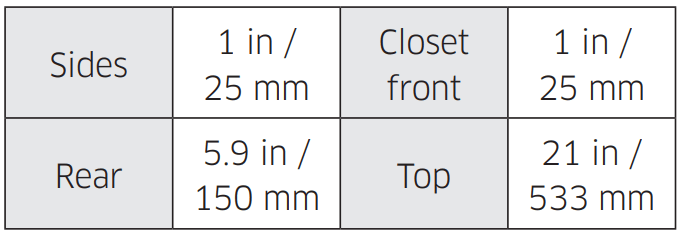
If the washer and dryer are installed together, the closet front must have at least a 72 in2 (465 cm2) unobstructed air opening.
Your washer alone does not require a specific air opening.
Required dimensions for Installation

Step-by-step installation
STEP 1 Selecting a location
Before you install the washer, make sure the location:
- Has a hard, level surface without carpeting or flooring that may obstruct ventilation.
- Is away from direct sunlight.
- Has adequate ventilation.
- Is not exposed to freezing temperatures (temperatures under 32 °F or 0 °C).
- Is away from heat sources such as oil or gas.
- Has enough space so that the washer doesn’t rest on its power cord.
STEP 2 Connecting the water supply hose
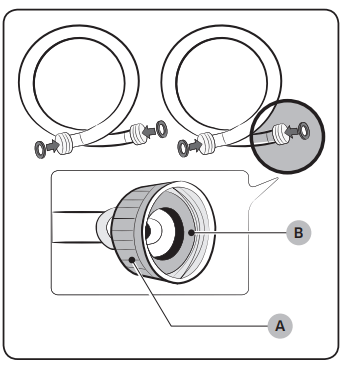 | CAUTION
|
 |
CAUTION When you fasten the fittings, do not fasten them too tightly or apply tape or sealant to the faucets or water supply intakes. This can damage the fittings. NOTE After you have connected the water supply hoses to the faucets, ensure that they are connected correctly by pulling the water supply hoses downwards. |
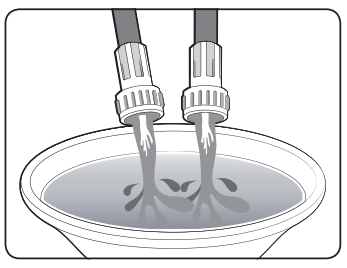 | 3. Place the unconnected ends of the hoses into a bucket and open the faucets connected to the two water supply hoses for 10 or 15 seconds to remove any foreign substances from the hoses. Close the faucets before continuing. |
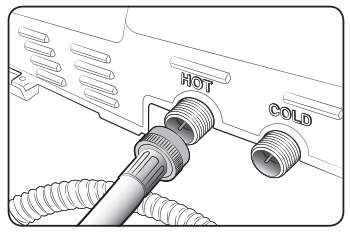 | Connect the ends of the water supply hoses to the water supply intake connections at the back of the washer. CAUTION The water supply hose connected to the hot faucet must be connected to the hot water supply intake and the water hose connected to the cold faucet must be connected to the cold water supply intake. |
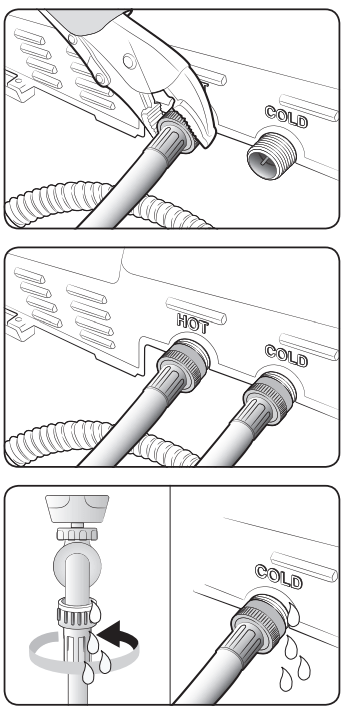 | Tighten the fittings by hand until they are snug, and then tighten them an additional two-thirds of a turn with a plier. NOTE To ensure the correct water usage, connect both the hot and cold water faucets. If either or both are not connected, an “4C” (no fill) code can be displayed. NOTE If you do not want to use the hot water supply hose, insert the water intake cap into the hot water supply intake hole. In this case, you must select the Tap Cold for the water temperature. If you select the Tap Cold, all the lamps for the water temperature options are turned off. CAUTION Confirm that the water supply hoses are not twisted or bent. If the hoses are twisted or bent, the hoses can leak and cause electric shock due to the water leakage. Turn on the hot and cold water supplies and check all the water supply intake connections and the faucets for water leaks. |
STEP 3 Connecting the drain hose
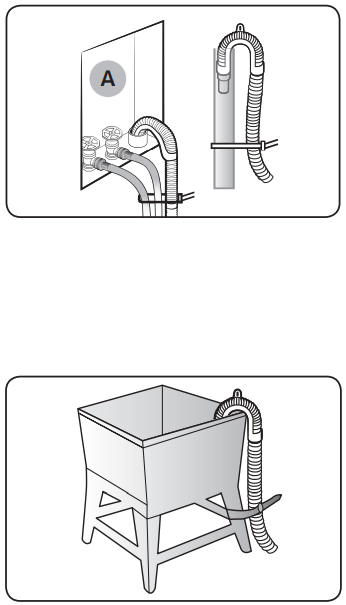 | The end of the drain hose can be positioned in three ways: In a Wall standpipe or Floor standpipe The height of end of standpipe must be no lower than 39 in (99 cm) and no higher than 96 in (245 cm). If drain pipe are built into the wall with water valves (A), fasten the drain hose to the water hose. NOTE Make sure that the connection between the drain hose and the standpipe is not airtight. In a laundry tub The height of the tub must be no lower than 39 in (99 cm) and no higher than 96 in (cm). Assemble the supplied Hose guide at the end of the drain hose, and put the hanger on laundry tub. And fasten the drain hose to the leg of laundry tub. |
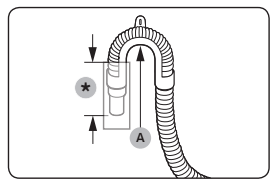 | NOTE Connect the hose guide (A) within 3~5 in (7.6-12.7 cm)* from the end of the drain hose. If the drain hose is extended beyond the end of the hose guide, mold or microorganisms could spread inside the washer. NOTE The drain hose can be installed to a 96 in (245 cm) maximum, but the draining capability can be reduced at this height. It can cause the washer to have an odor because of remaining water in the drain system. NOTE If the drain hose is installed below 39 in (99 cm), water can be drained in cycles due to a siphon phenomenon. It causes the washer to display “4C”. |
STEP 4 Leveling your washer
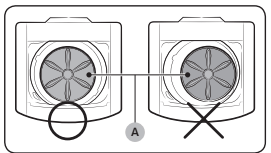 | See if the washer is level by checking the position of the tub:
|
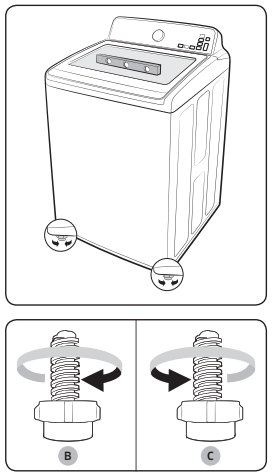 | 3. If the washer is level, the pulsator (A) is positioned at the center of the water as shown in the figure. If not, level your washer by turning the front leveling feet clockwise or counterclockwise as necessary. NOTE Turn the front leveling feet clockwise (B) to lower the washer, and counterclockwise (C) to raise the washer. |
STEP 5 Powering your washer
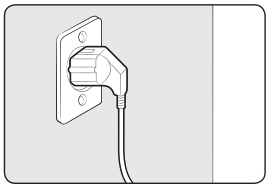 | Plug the power cord into a 3-prong, well grounded 120 volt 60 Hz approved electrical outlet protected by a 15-amp fuse or comparable circuit breaker. Your washer is grounded through the third prong of the power cord when plugged into a three-prong grounded electrical outlet. Test run Make sure that you install your washer correctly by running the Rinse+Spin after the installation is complete. |
STEP 6 Running a test cycle
Run a test cycle as follows to check if your washer is properly installed.
- Load about 6 pounds of laundry into the tub.
- Press POWER to turn on your washer.
- Select Rinse+Spin by turning the Cycle Selector.
- Press START/PAUSE to start the test cycle.
- The washer should not rock or vibrate excessively when water is supplied or when washing or spinning, and should drain well during the spin cycle.
NOTE
- If water leaks while water is being supplied or drained, check the water connections.
- If the washer rocks and vibrates excessively, level your washer again.
STEP 7 Run calibration (recommended)
Calibration ensures accurate weight detection by the washer. Make sure the tub is empty before running calibration.
- Press POWER to turn on the washer.
- Press and hold Temp. and Soil simultaneously for 3 seconds.
- Press START/PAUSE to start calibration.
- The tub rotates clockwise for approximately 2 minutes.
- When complete, “0” appears on the display, and the washer turns off automatically.
NOTE
Run Calibration Mode periodically for more accurate weight detection.
OPERATION
Loading
- Fill the tub with dry, unfolded clothes evenly around in order to enhance washing efficiency and prevent excess wear, or wrinkling of the load.
- For optimal washing performance, make sure the laundry is piled up evenly.
- Wash delicate items such as bras, hosiery, and other lingerie in the Delicates cycle with similar lightweight items.
- When washing big bulky items or a few smaller items that don’t fill the tub completely – a rug, a pillow, stuffed toys, or one or two sweaters, for example – add a few towels to improve spin performance.
- Do not insert bulky items except for Bedding in this cycle.
NOTE
- During the spin cycle, the washer may add additional water to redistribute the clothes and correct an imbalance inside the drum.
- When washing heavily soiled loads, do not overload your washer to ensure good cleaning results.
CAUTION
- Inflatable items may cause damage to the laundry or the machine during the wash or drying process.
- Regardless of the size, blankets or quilts are safer and cleaner to wash one item at a time. Two different-sized blankets in the same load may compromise the drying performance due to unbalanced loads.
To input a blanket
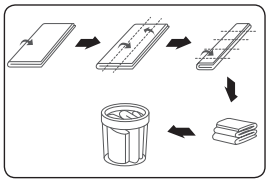 | Fold the blanket into the blanket-specific net as shown, and then insert in the tub below the plastic area of the tub. CAUTION Make sure the laundry is inserted completely.
|
To add a forgotten item:
- Press START/PAUSE to pause the washer.
- Wait for the door to unlock automatically, and then open the door.
- Add the item, close the door, and then press START/PAUSE. The cycle will resume.
Getting started
- Load your washer.
- Add liquid (or powder) detergent and additives to the dispenser (see the "Detergent use" section on page 40).
- Select the appropriate cycle and options for the load (see the "Washing a load of laundry" section page 30).
- Close the lid.
- Press START/PAUSE.
- The Wash Indicator illuminates.
- The estimated cycle time will appear in the display. The time may fluctuate to indicate the time remaining in the cycle.
NOTE
The actual time required for a cycle may differ from the estimated time in the display depending on the water pressure, water temperature, detergent, and laundry.
8. Before your washer starts to fill, it will make a series of clicking noises to check the door lock and do a quick drain.
NOTE
- When the cycle is complete, the Door Lock indicator will go out and “0” will appear in the display.
- Pressing POWER cancels the cycle and stops your washer.
- The Wash, Rinse, and Spin indicators will illuminate during those portions of the cycle.
FUNCTIONS
Control panel



Cycle overview
The washer detects the weight of the items and automatically adjusts the optimal water level, washing time, rinse counts, and spin counts. (This may not be applicable on some cycles.)


Child Lock
- Press and hold Temp. and Water Level simultaneously for approximately 3 seconds.
- When you activate the Child Lock function, the Child Lock indicator blinks.
Using the Child Lock function
If the lid is opened when the Child Lock function is on, “dC” is displayed and an alarm sounds.
- If the water level in the tub is above the safe water level, “dC” is displayed on the LED display and the washer starts to drain water by force after 30 seconds.
- If the water level in the tub is above the safe water level and the Child Lock function is turned on while the door is open, “CL” is displayed on the LED display even if the power of the washer is turned off and the washer drains water by force.
- Even if the power of the washer is turned off, if the lid is opened while the water level in the tub is above the Reset water level, “CL” is displayed on the LED display without the alarm sounding and the washer starts to drain water. When the draining operation finishes, the power is automatically turned off again.
You have activated the Child Lock function while the washer is running, the START/PAUSE button will not work.
- After the compulsory drain, the “CL” blinks at 1 second intervals and the product enters the “CL” mode. (When the product is in the “CL” mode, only the POWER button works.)
- To cancel the “CL” mode, you need to turn the power off and then on again.
- To cancel the “dC” mode, deactivate the Child Lock function. To deactivate the Child Lock function, press and hold Temp. and Water Level simultaneously for at least 3 seconds.
NOTE
Adding laundry when Child Lock is on
To add laundry, deactivate the Child Lock function. To deactivate the Child Lock function, press and hold Temp. and Water Level simultaneously for at least 3 seconds
Deactivating the Child Lock function
Press and hold both Temp. and Water Level simultaneously for approximately 3 seconds.
- When you deactivate the Child Lock function, the Child Lock indicator is turned off.
- The Child Lock function prevents children or the infirm from accidently operating the washer and injuring themselves.
WARNING
If a child enters the washer, the child may become trapped and suffocate.
CAUTION
- Once you have activated the Child Lock function, it continues working even if the power is turned off.
- Forcing the lid open can result in injury or damage to the product.
NOTE
To add laundry after you have activated the Child Lock function, you must first deactivate the Child Lock function.
Alarm Off
When the alarm is off, the cycle completion melody and the power-off beep will not sound. However, button and alert sounds will remain on.
- To mute the alarm sound, press and hold Extra Rinse for 3 seconds.
- To unmute the alarm sound, press and hold again for 3 seconds.
Your setting will be kept even after you turn off and then restart the machine.
Garment Plus
You can add or take out laundry items even after the wash has started, as long as the Garment Plus indicator is on.
Pressing START/PAUSE unlocks the lid. If you open the lid and want to continue the wash cycle, close the lid, and then press START/PAUSE.
Delay End
You can set the washer to start your wash automatically at a later time, by choosing a delay time.
The hour displayed indicates the time at which the wash will be ended.
- Set your wash cycle.
- Press Delay End repeatedly until the delay time is set.
- Press START/PAUSE. The “Delay End” indicator will be lit, and the clock will begin counting down until it reaches the set time.
- To cancel a Delay End function, press the POWER button and then turn the washer on again.
Pre Soak
Use this function when the laundry is heavily contaminated or stained. This function improves the wash performance by adding a Pre Soak cycle.
- If you select this function, the total cycle time is increased by 18 minutes.
- When the Pre Soak cycle starts, the washer repeats a wash cycle after supplying water and then performs a minute soak cycle.
- When the Pre Soak cycle is complete, the configured wash cycle starts without draining water.
Smart Care
To enable this function, you must first download the Samsung Laundry app from the Play Store or the App Store and install it on a mobile device that has a camera function. The Smart Care function has been optimized for Galaxy and iPhone mobile devices (applicable models only).
- When the washer detects an issue to check, an information code appears on the display. To enter Smart Care mode, press Smart Care.
- The washer starts the self-diagnosis procedure and displays an information code if a problem is detected.
- Run the Samsung Laundry app on your mobile device, and then tap Smart Care.
- Put the mobile device close to the washer’s display so that the smartphone camera and the washer face each other.
- The information code will be recognized automatically by the app.
- When the information code is recognized correctly, the app provides detailed information about the problem with applicable solutions.
NOTE
- The function name, Smart Care, may differ depending on the language.
- If the washer's display reflects light, the app may fail to recognize the information code.
- If the app fails to recognize the information code, you can enter the code manually on the app.
Washing clothes using the cycle selector
Your new washer makes washing clothes easy, using Samsung’s “Fuzzy Control” automatic control system. When you select a wash program, the machine will set the correct temperature, washing time, and washing speed.
- Press POWER.
- Open the lid.
- Load the articles of clothing one at a time loosely into the drum, without overfilling it.
- Add liquid (or powder) detergent, softener, and/or bleach (if necessary) to the appropriate compartments.
- Close the lid.
- Use the Cycle Selector to select the appropriate cycle according to the type of material: NORMAL, HEAVY DUTY, DEEP WASH, BEDDING/WATERPROOF, PERM PRESS, QUICK WASH, DELICATES, RINSE+SPIN, and SPIN ONLY. The relevant indicators will illuminate on the control panel.
- At this time, you can control the wash temperature, the number of rinse cycles, the spinning speed, and the delay time by pressing the appropriate option button.
- Press START/PAUSE and the wash will begin. The process indicator will light up and the remaining time for the cycle will appear in the display.
Pause Option
To remove or add laundry items, follow these steps:
- Press START/PAUSE to unlock the lid.
- NOTE The lid cannot be opened when the water is too HOT.
- Remove or add laundry items.
- Close the lid, and then press START/PAUSE to restart the wash.
When the cycle is finished:
After the total cycle has finished, the power will turn off automatically.
- Open the lid.
- Remove laundry.
ATC (Auto Temperature Control)
ATC is the control function that the washer controls water temperature with temperature sensor (thermistor).
- Because there are numerous water temperatures depending on the customer’s environments (cold areas, warm areas, various water temperatures, settings of heater temperature, etc.), ATC function in our washer maintains the certain level of wash temperature to output the best washing performance at each cycle.
- If you select NORMAL cycle, this cycle is the regulation and UL cycle. Since new washers must reduce the amount of energy usage as a first priority, customers will notice more cold water entering the washer. But, this is normal, not a problem.
- In those regulation cycles, Hot temperature is similar to acceptable adult bath-water temperature and warm temperature is similar to comfortable swimming-pool water temperature.
- If customers want to wash clothes in specific water temperatures, customers should choose a different cycle at each temperature (Hot/Warm/Eco Warm).
Features
Automatic dispenser
Your washer has separate compartments for dispensing detergent and color-safe bleach and fabric softener. Add all laundry additives to their respective compartments before starting your washer.
The automatic dispenser must always be in place before you start your washer.
DO NOT open the automatic dispenser when your washer is running.
NOTE
- Never exceed the manufacturer’s recommendations when adding detergent.
- This compartment holds liquid detergent for the main wash cycle, which is added to the load at the beginning of the cycle.
- When using powdered detergent, remove the liquid detergent compartment from the detergent drawer. The washer will not dispense powdered detergent from the liquid detergent compartment.
To add detergent to the automatic dispenser:
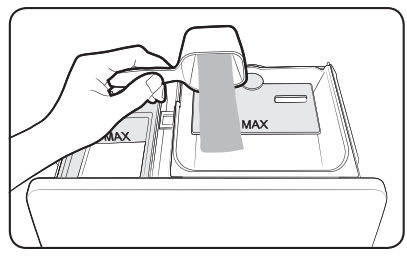 |
NOTE It is normal for a small amount of water to remain in the dispenser compartments at the end of the cycle. Do not put chlorine bleach in the dispenser drawer. |
Loading the Liquid (or Powder) detergent compartment
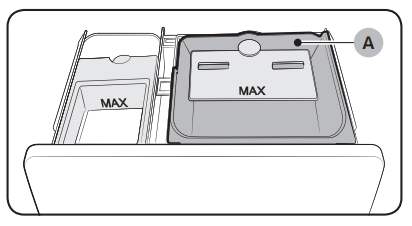 |
NOTE When adding color-safe bleach with detergent, it is best if both laundry products are in the same form – liquid. When using powdered detergent, remove the liquid detergent compartment (A) from the detergent drawer. The washer will not dispense powdered detergent from the liquid detergent compartment. |
Loading the Bleach compartment
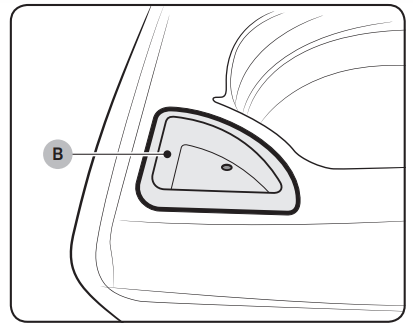 | CAUTION Use the liquid chlorine bleach only.
DO NOT exceed the bleach compartment. NOTE
|
Loading the fabric softener compartment

- Pour the recommended amount of liquid fabric softener into the softener compartment (C). For smaller loads, use less than one capful.
- Dilute the fabric softener with water until it reaches MAX FILL in the compartment.
- The dispenser automatically releases liquid fabric softener at the proper time during the rinse cycle.
NOTE
- Use the softener compartment ONLY for liquid fabric softeners.
- DO NOT use the Downy Ball* in the fabric softener compartment with this washer. It will not add fabric softener at the appropriate time.
- Do not use liquid fabric softener that is too sticky as it may not mix with the water sufficiently.
MAINTENANCE
Cleaning the exterior
- Turn off the water faucets after finishing the day’s washing.This will shut off the water supply to your washer and prevent the unlikely possibility of damage from escaping water. Leave the lid open to allow the inside of your washer to dry out.
- Use a soft cloth to wipe up all detergent, bleach or other spills as they occur.
- Clean the following as recommended: Control Panel – Clean with a soft, damp cloth. Do not use abrasive powders or cleaning pads. Do not spray cleaners directly on the panel.
Cleaning the interior
Clean the interior of your washer periodically to remove any dirt, soil, odor, mold, mildew, or bacterial residue that may remain in your washer as a result of washing clothes.
Failure to follow these instructions may result in unpleasant conditions, including odors and/or permanent stains on your washer or laundry.
Hard water deposits may be removed, if needed. Use cleaners labeled “Washer safe”.
Storing your washer
Washers can be damaged if water is not removed from hoses and internal components before storage.
Prepare your washer for storage as follows:
- Select the Quick Wash cycle and add bleach to the automatic dispenser. Run your washer through the cycle without a load.
- Turn the water faucets off and disconnect the inlet hoses.
- Unplug your washer from the electrical outlet and leave your washer lid open to let air circulate inside the drum. If your washer has been stored in below–freezing temperatures, allow time for any leftover water in your washer to thaw out before use.
Preserving the top cover and the front frame
Do not place any heavy or sharp objects or a detergent box on the washer. They can scratch or damage the top cover of the unit.
NOTE
- Since the entire washer has a high-gloss finish, the surface can be scratched or damaged.
- Avoid scratching or damaging the surface when using the washer.
Cleaning mesh filter
Clean the mesh filter of the water hose once or twice a year.
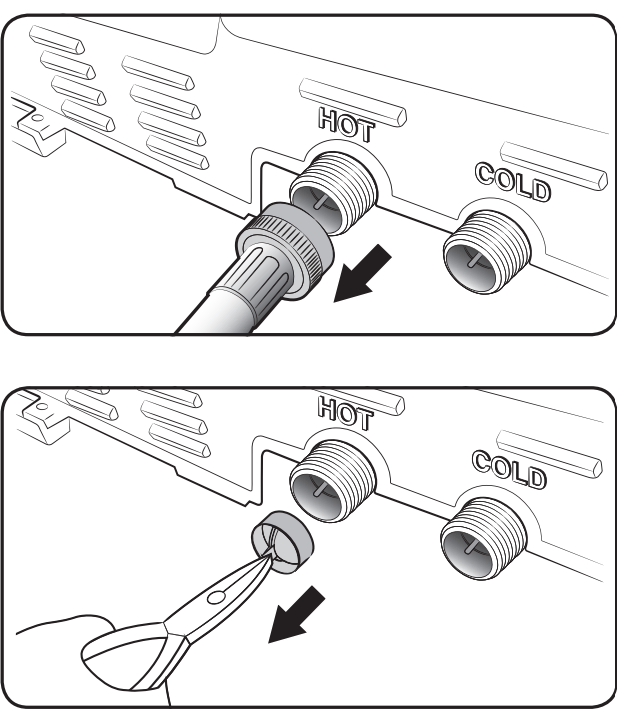 |
|
NOTE
If the mesh filter is clogged, the “4C” information code appears on the the washer’s display screen.
Cleaning the dispensers
 | The automatic dispenser may need to be cleaned periodically due to laundry additive buildup. 1. Pull the dispenser drawer straight back until it stops. |
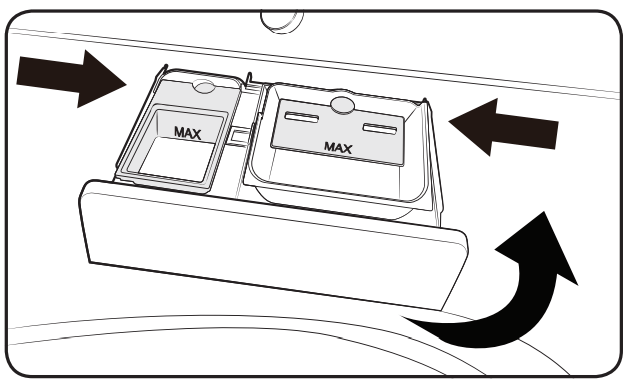 | 2. While pushing both sides of the dispenser drawer, lift and pull it to remove. |
 | 3. Remove the inserts from the 3 compartments. Rinse the inserts and the drawer with warm water to remove traces of accumulated laundry products. |
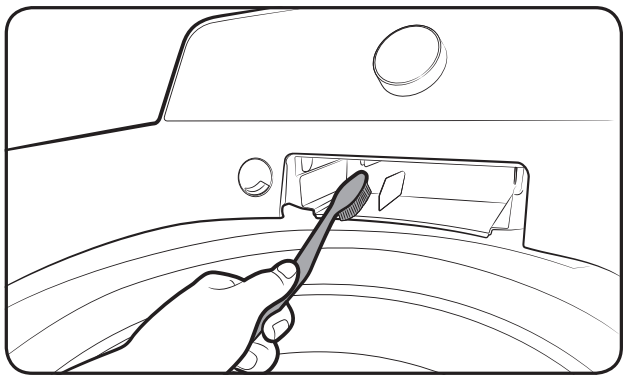 | 4. To clean the drawer opening, use a small, non-metal brush to clean the recess. Remove all residue from the upper and lower parts of the recess. |
 | 5. Return the inserts to the proper compartments and replace the drawer by placing the dispenser drawer rail (B) on top of the compartment rail (A) (Tilt the dispenser drawer downward and insert it). Then push the drawer in firmly and slowly. |
Self Clean
Certain usage and environmental conditions may result in some residue build-up or odor in the washer tub. To prevent this build-up of residue or odor causing bacteria and keep your washer tub fresh and clean, perform the Self Clean cycle at least once a month or every 20 cycles.
Perform the recommended procedure below when using the Self Clean cycle.
- Remove all items from the washer tub and ensure the tub is empty. Laundry left in the tub during the Self Clean cycle may be damaged.
- Press POWER.
- Turn the Cycle Selector to SELF CLEAN.
- Press START/PAUSE. Self Clean begins.
NOTE
- The water temperature for Self Clean is defaulted to Hot. This temperature cannot be changed.
- In the case where residue is present in the washer tub, add 1 cup (8 fl.oz, 240 ml) of liquid chlorine bleach to the bleach compartment before you start the Self Clean cycle. Do not use or mix any other detergent or chemicals during the Self Clean cycle.
- If necessary, run a RINSE+SPIN Cycle after the Self Clean cycle has completed to help remove any remaining residue.
CAUTION
- Check the washer tub before using the Self Clean cycle. Remove any remaining water in the tub by running a SPIN cycle prior to starting the Self Clean cycle.
- If there is chlorine bleach left in the washer tub for an extended period of time, rust can occur.
Self Clean reminder
After 20 washing cycles, the Self Clean LED reminder icon and the Self Clean cycle LED will blink on the control panel for an hour and then turn off automatically.
The reminder will appear on the control panel for 5 additional consecutive cycles before turning off. The next reminder will not appear until another 20 cycles have been completed.
TROUBLESHOOTING
Problem | Action |
| Does not turn on. |
|
| Does not start. |
|
| Water is not supplied. |
|
| After a cycle, detergent remains in the automatic dispenser. |
|
| Vibrates excessively or makes noise. |
|
| Stop. |
|
| Fills with the wrong temperature water. |
|
| Door (Lid) locked or will not open. |
|
| Does not drain and/ or spin. |
|
| Load is wet at the end of the cycle. |
|
| Leaks water. |
|
| Excessive suds. |
|
| The spin basket or drain/supply hose is frozen. |
|
| Water drains out immediately. |
|
| Stains on clothes. |
|
| Has odours. |
|
Information codes
4C
Water is not supplied.
• Make sure the water taps are open.
• Make sure the water hoses are not clogged.
• Make sure the water taps are not frozen.
• Make sure the washing machine is operating with sufficient water pressure.
• Make sure that the cold water tap and the hot water tap are properly connected.
• Clean the mesh filter as it may be clogged.
NOTE
When the washer displays “4C”, the washer do draining for
3 minutes. During this time, the POWER button is inoperative.
4C2
• Make sure the cold water supply hose is firmly connected to the cold water tap.If it is connected to the hot water tap, the laundry may be
deformed with some cycles.
5C
Water is not draining.
• Make sure the drain hose is not frozen or clogged.
• Make sure the drain hose is positioned correctly, depending on the connection type.
• Clean the debris filter as it may be clogged.
• Make sure the drain hose is straightened all the way to the drain system.
• If the information code remains, contact a customer service centre.
9C1
The electronic control needs to be checked (Over Voltage Error).
• Check the PCB and wire harness.
• Check if power is supplied properly.
• If the information code remains, contact a customer service centre.
9C2
Low voltage detected
• Check if the power cord is plugged in.
• If the information code remains, contact a customer service centre.
AC6
Inverter Communication problem
• Check the Inverter PCB and wire harness.
• If the information code remains, contact a customer servicecentre.
dC
Operating the washer with the door open.
• Make sure the door is properly closed.
• Make sure laundry is not caught in the door.
HC
High temperature heating check.
• If the information code remains, contact a customer servicecentre.
LC
Check the drain hose.
• Make sure the end of the drain hose is placed on the floor.
• Make sure the drain hose is not clogged.
• If the information code remains, contact a customer servicecentre.
NOTE
When the washer displays “LC”, the washer do draining for3 minutes. During this time, the POWER button is inoperative.
OC
Water is overflowed.
• Restart after spinning.
• If the information code remains on the display, contact a local Samsung service centre.
PC
When position of the clutch can't be detected.
• If the information code remains, contact a customer service centre.
PC1
After position of the clutch is detected, if the signal of the clutch hall goes wrong.• If the information code remains, contact a customer service centre.
Ub
Spinning does not work.
• Make sure laundry is spread out evenly.
• Make sure the washing machine is on a flat, stable surface.
• Redistribute the load. If only one item of clothing needs washing, such as a bathrobe or pair of jeans, the final spin result might be unsatisfactory, and an “Ub” check message will be shown in the display.
Ur
Additional rinsing.
• Show additional rinsing in sensing unbalance.
• Method of releasing the display. Any key input.
See other models: DVG45T3400P/A3 DVE45T3400P/A3 DW80R2031UB/AA NP740U3L-L02US WW80TA046AX/EU
